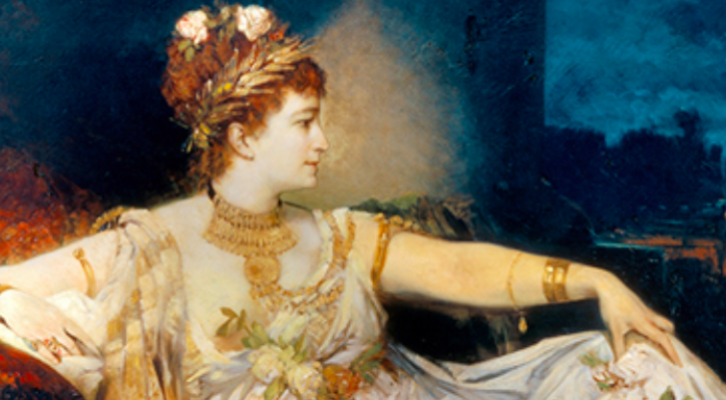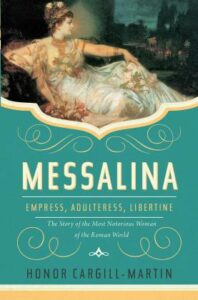
The Making of a Bad Woman (2,000 Years Ago)
Honor Cargill-Martin on the Historical Construction of the Scandalous Roman Empress Messalina
In the autumn of 48 AD, the scandalous ancient Roman empress Messalina was accused of bigamously marrying her lover, and summarily stabbed to death. Her death ‘shook the imperial house’ but it also left the position of empress open for the taking.
A contest of sorts was held: three men, all ambitious court advisors, pitched three women to the emperor Claudius. One was the beautiful, jewel-obsessed heiress Lollia Paulina; another was Claudius’ ex-wife, Aelia Paetina, the uncomplaining mother of his eldest daughter; the last was the politically astute imperial princess Agrippina the Younger, mother of the future emperor Nero. The three women were discussed, their pros and cons presented, their assets and flaws picked over—in the end it was Agrippina who won out.
The story, as we have it, feels off. Its setting, as the three advisors gather in a single meeting to pitch their candidates to the emperor, is almost corporate; its structure—a man asked to bestow a prize on one of three competing women, each offering him something different—runs far too close to the myth of Golden Apple.
The strange scene sketched above was composed by Tacitus, Rome’s greatest historian, some three quarters of a century after the events themselves were meant to have taken place. The interval was short enough for Tacitus to have known men who’d lived through it, but long enough to grant him a degree of room for maneuver. These three women might all have been considered as potential brides for Claudius in 48 AD, but the mise-en-scène is likely to be Tacitus’ own invention.
The ancient attitude to history writing was different to our own. They made no distinction between “academic” and “narrative” history. To the Roman historian, the tools of the writer—physical description, characterization, reported dialogue, set-piece speeches—were equally tools of his own. They served not only to give his work literary merit, but also let him say what he thought. They sat alongside evidence and argument as tools of analysis and expression.
The histories of women in this period were more malleable than those of men. Men made speeches that were written into the official senatorial records and stored in the official senatorial archives. Sometimes a whole imperial speech would be transcribed and engraved onto bronze plaques to be hung in some or other forum.
The same was not true for women, not even for the most powerful. In this period imperial women exerted their influence behind the scenes. Their (very significant) power derived from their unmediated access to the emperor. They altered the course of Rome through their social networks on the Palatine and their one-on-one chats with the ruler.
Things were informal and ill-documented, and this left ample space for the Roman historian. To some degree he could characterize the imperial women as he saw fit—playing attributes up or down until they served his narrative or reflected his wider historical message. He could take apart and re-construct women to suit his purposes.
*
The three women Tacitus places in contest for the ailing, fifty-eight-year-old emperor’s hand in marriage are carefully differentiated. Lollia Paulina is glamorous and girly; Aelia Paetina, stable and motherly; Agrippina, ambitious and masculine. They are contrasted not only in their literal competition but also in their very being.
Such emphasis on contrast does not end with the resolution of the marriage-debate—rather, it intensifies. Tacitus’ first proper description of the new empress, Agrippina, defines her in opposition to her predecessor Messalina:
The state was transformed and the whole was subject to a woman, one who didn’t make a mockery of the very stuff of Rome with her dissoluteness, as Messalina had. This was a strict and quasi-masculine slavery; openly severe and always arrogant. Nothing immodest now happened in the home—unless it hastened domination.
We feel the same contrast implicitly all throughout the telling of these women’s stories.
The ancient sources present the empress Messalina as a dangerous vision of femininity taken to its logical extreme. To the Romans, women were less rational, more emotional, less self-controlled, more sensual—and the stories told about Messalina embody all these ancient prejudices. She falls in love and is unable to be subtle about it. Her desires are so uncontrolled that she slips from the palace nightly to work in a low-class brothel—and still leaves unsatisfied. She kills one of the richest senators in Rome because she wants his pleasure gardens. She makes momentous political decisions based on passing whims, lusts, jealousy, love—but never logic or judgement.
The more frivolous, irrational, stupid, capricious, passionate and carnal Roman writers made Messalina, the more political, rational, self-controlled, ambitious, and cold they made Agrippina. Both women excelled at the game of imperial politics—building networks of alliance and ruthlessly ousting their enemies—both lasted almost a decade at the top of the most cutthroat court on earth, and both met with violent, politically motivated ends. And yet here they are, transformed into irreconcilably opposite “types” of womanhood.
But why?
In part, the answer is a depressingly simple one. Readers, then as now, craved variation; and it is only through comparison that we can sense variety. High contrast is a quick and easy way to draw a number of distinct characters in a short period of time. A word or two of comparison allowed ancient authors to keep their readers entertained, without derailing their narratives. “Look at all these people,” they seem to say, “all so different, mostly so awful.”
In the extreme contrast he draws between these two women, Tacitus presents a world in which female power—and the imperial system which enables it—is always corrupting, always dangerous.
And yet this surely cannot be the whole explanation? The three men—Callistus, Narcissus and Pallas—who debate the virtues of Claudius’ potential brides are never characterized in such stark terms as their candidates; although they, as influential ex-slave advisors, occupied a similarly shadowy and re-writable place in the imperial court.
No, the impulse to contrast seems to be directed disproportionally against women, on account of their womanhood. But why?
The answer, I think, is two-fold. Firstly, contrast engenders extremity, and this extremity allowed ancient writers to clarify a set of political messages for which women had come to act as symbols. To senatorial writers like Tacitus, the very existence of powerful women was symptomatic of political degeneration. They embodied the loss of the old Republic, controlled by its all-male senate, and the emergence of a quasi-monarchical empire, where women had their heirs and held court.
In his competing characterizations of Messalina and Agrippina, Tacitus presents us with a comprehensive criticism of female power. Messalina—dangerous in the extent of her femininity—corrupts the political space: decisions are made on the basis of her uncontrolled feelings, senators are executed on the whims of her jealousies or desires. Agrippina, by contrast, is corrupted by her improper involvement in politics: she becomes ambitious, cold, ruthlessly logical, a monstrously masculine woman. In the extreme contrast he draws between these two women, Tacitus presents a world in which female power—and the imperial system which enables it—is always corrupting, always dangerous.
But the impulse to construct through contrast also speaks to something deep at the heart of ancient thought about the nature of woman. The ancients had no Victorian perception of women as sexless creatures who submitted to men’s desires merely for family, or country, or profit. The poet Ovid, writing some fifty years before Messalina’s death, had warned his fellow men that woman’s lusts was “sharper than ours, it bears more of madness.”
To the Romans, masculinity was about control. Control of the self, control of the country, control of your women. Femininity was the opposite. Intrinsically uncontrolled, emotional, illogical, visceral even. It required external, masculine control, but it also eluded rational masculine explanation.
In this context, the pitching of women like Messalina and Agrippina against one another emerges clearly as a strategy of control. If we strip away the opinion (so far as that is possible), and simply list the actions ascribed to these empresses in the ancient sources the picture we get is a complex and sometimes conflicting one: these are women who protect their children and murder their enemies, have desires and ambitions, bide their time and act rashly, form strategies and make errors.
By painting these women less through description than through contrast, ancient writers can simplify the picture. They transform real women into disparate archetypes of feminine “badness.” In doing so, they justify their fear of female power but they also allay their anxieties about female complexity. As Messalina and Agrippina are simplified down to their differences, they become reassuringly pigeonholed, clear to read in relief. They are constructed, categorized, and easy to censure.
______________________________

Messalina by Honor Cargill-Martin is available now via Pegasus Books.
Honor Cargill-Martin
Honor Cargill-Martin is an author, classicist, and art historian. She studied Classical Archaeology and Ancient History at Oxford, winning a scholarship and graduating with a first-class degree. She remained at Oxford to complete a masters in Greek and Roman history before going on to study for a second masters in Italian Renaissance Art History at The Courtauld Institute of Art. Messalina is her first book.



















